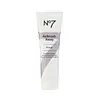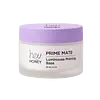What's inside
What's inside
 Key Ingredients
Key Ingredients

 Benefits
Benefits

 Concerns
Concerns

 Ingredients Side-by-side
Ingredients Side-by-side

Cyclopentasiloxane
EmollientWater
Skin ConditioningButylene Glycol
HumectantDimethicone Crosspolymer
Emulsion StabilisingHdi/Trimethylol Hexyllactone Crosspolymer
Cyclohexasiloxane
EmollientSilica
AbrasivePhenyl Trimethicone
Skin ConditioningCaprylic/Capric Triglyceride
MaskingGalactoarabinan
Glycerin
HumectantMagnesium Sulfate
PEG/PPG-18/18 Dimethicone
EmulsifyingPhenoxyethanol
PreservativeCetyl PEG/PPG-10/1 Dimethicone
EmulsifyingPolyglyceryl-4 Isostearate
EmulsifyingHexyl Laurate
EmollientParfum
MaskingMethylparaben
PreservativeEthylparaben
PreservativeSilica Dimethyl Silylate
EmollientDipropylene Glycol
HumectantTetrasodium EDTA
Sodium Hyaluronate
HumectantCI 77891
Cosmetic ColorantCI 77491
Cosmetic ColorantCyclopentasiloxane, Water, Butylene Glycol, Dimethicone Crosspolymer, Hdi/Trimethylol Hexyllactone Crosspolymer, Cyclohexasiloxane, Silica, Phenyl Trimethicone, Caprylic/Capric Triglyceride, Galactoarabinan, Glycerin, Magnesium Sulfate, PEG/PPG-18/18 Dimethicone, Phenoxyethanol, Cetyl PEG/PPG-10/1 Dimethicone, Polyglyceryl-4 Isostearate, Hexyl Laurate, Parfum, Methylparaben, Ethylparaben, Silica Dimethyl Silylate, Dipropylene Glycol, Tetrasodium EDTA, Sodium Hyaluronate, CI 77891, CI 77491
Water
Skin ConditioningCaprylic/Capric Triglyceride
MaskingCyclopentasiloxane
EmollientGlycerin
HumectantSodium Polyacryloyldimethyl Taurate
Emulsion StabilisingDimethicone Crosspolymer
Emulsion StabilisingIsohexadecane
EmollientPhenoxyethanol
PreservativeMica
Cosmetic ColorantCI 77891
Cosmetic ColorantXylitylglucoside
HumectantAnhydroxylitol
HumectantPolysorbate 80
EmulsifyingEthylhexylglycerin
Skin ConditioningXylitol
HumectantIron Oxides
CI 77491
Cosmetic ColorantCI 75470
Cosmetic ColorantHoney Extract
HumectantParfum
MaskingSodium Hyaluronate
HumectantTin Oxide
AbrasiveCI 77492
Cosmetic ColorantHexamethylindanopyran
MaskingAcetyl Cedrene
Potassium Sorbate
PreservativeSorbic Acid
PreservativeWater, Caprylic/Capric Triglyceride, Cyclopentasiloxane, Glycerin, Sodium Polyacryloyldimethyl Taurate, Dimethicone Crosspolymer, Isohexadecane, Phenoxyethanol, Mica, CI 77891, Xylitylglucoside, Anhydroxylitol, Polysorbate 80, Ethylhexylglycerin, Xylitol, Iron Oxides, CI 77491, CI 75470, Honey Extract, Parfum, Sodium Hyaluronate, Tin Oxide, CI 77492, Hexamethylindanopyran, Acetyl Cedrene, Potassium Sorbate, Sorbic Acid
Ingredients Explained
These ingredients are found in both products.
Ingredients higher up in an ingredient list are typically present in a larger amount.
This ingredient is an emollient, solvent, and texture enhancer. It is considered a skin-softener by helping the skin prevent moisture loss.
It helps thicken a product's formula and makes it easier to spread by dissolving clumping compounds.
Caprylic Triglyceride is made by combining glycerin with coconut oil, forming a clear liquid.
While there is an assumption Caprylic Triglyceride can clog pores due to it being derived from coconut oil, there is no research supporting this.
Learn more about Caprylic/Capric TriglycerideCi 77491 is also hydrated iron III oxide. It's sole purpose is to give a red/pink hue to products.
Iron III oxides are classified as inorganic chemicals for coloring.
Synthetically created Ci 77491 is considered safer than those naturally found. This is because the synthetically created version may contain less impurities. Iron oxides are generally non-toxic and non-allergenic.
Learn more about CI 77491Ci 77891 is a white pigment from Titanium dioxide. It is naturally found in minerals such as rutile and ilmenite.
It's main function is to add a white color to cosmetics. It can also be mixed with other colors to create different shades.
Ci 77891 is commonly found in sunscreens due to its ability to block UV rays.
Learn more about CI 77891Cyclopentasiloxane, or D5, is a silicone used to improve texture of products and trap moisture.
D5 is considered lightweight and volatile. Volatile means it evaporates quickly after application. Once evaporated, D5 leaves a thin barrier that helps keep skin hydrated.
It is also an emollient. Emollients help soften the skin and prevent water loss. Silicones create a silky texture in products. D5 helps other ingredients become more spreadable.
Studies show D5 is safe to use in skincare products. We recommend speaking with a skincare professional if you have concerns.
Learn more about CyclopentasiloxaneDimethicone Crosspolymer is a silicone created by modifying dimethicone with hydrocarbon side chains. Due to its large size, it does not penetrate skin. It is considered non-occlusive.
Dimethicone Crosspolymer is used to stabilize and thicken products. It also helps give products a silky feel.
Glycerin is already naturally found in your skin. It helps moisturize and protect your skin.
A study from 2016 found glycerin to be more effective as a humectant than AHAs and hyaluronic acid.
As a humectant, it helps the skin stay hydrated by pulling moisture to your skin. The low molecular weight of glycerin allows it to pull moisture into the deeper layers of your skin.
Hydrated skin improves your skin barrier; Your skin barrier helps protect against irritants and bacteria.
Glycerin has also been found to have antimicrobial and antiviral properties. Due to these properties, glycerin is often used in wound and burn treatments.
In cosmetics, glycerin is usually derived from plants such as soybean or palm. However, it can also be sourced from animals, such as tallow or animal fat.
This ingredient is organic, colorless, odorless, and non-toxic.
Glycerin is the name for this ingredient in American English. British English uses Glycerol/Glycerine.
Learn more about GlycerinParfum is a catch-all term for an ingredient or more that is used to give a scent to products.
Also called "fragrance", this ingredient can be a blend of hundreds of chemicals or plant oils. This means every product with "fragrance" or "parfum" in the ingredients list is a different mixture.
For instance, Habanolide is a proprietary trade name for a specific aroma chemical. When used as a fragrance ingredient in cosmetics, most aroma chemicals fall under the broad labeling category of “FRAGRANCE” or “PARFUM” according to EU and US regulations.
The term 'parfum' or 'fragrance' is not regulated in many countries. In many cases, it is up to the brand to define this term.
For instance, many brands choose to label themselves as "fragrance-free" because they are not using synthetic fragrances. However, their products may still contain ingredients such as essential oils that are considered a fragrance by INCI standards.
One example is Calendula flower extract. Calendula is an essential oil that still imparts a scent or 'fragrance'.
Depending on the blend, the ingredients in the mixture can cause allergies and sensitivities on the skin. Some ingredients that are known EU allergens include linalool and citronellol.
Parfum can also be used to mask or cover an unpleasant scent.
The bottom line is: not all fragrances/parfum/ingredients are created equally. If you are worried about fragrances, we recommend taking a closer look at an ingredient. And of course, we always recommend speaking with a professional.
Learn more about ParfumPhenoxyethanol is a preservative that has germicide, antimicrobial, and aromatic properties. Studies show that phenoxyethanol can prevent microbial growth. By itself, it has a scent that is similar to that of a rose.
It's often used in formulations along with Caprylyl Glycol to preserve the shelf life of products.
Sodium Hyaluronate is hyaluronic acid's salt form. It is commonly derived from the sodium salt of hyaluronic acid.
Like hyaluronic acid, it is great at holding water and acts as a humectant. This makes it a great skin hydrating ingredient.
Sodium Hyaluronate is naturally occurring in our bodies and is mostly found in eye fluid and joints.
These are some other common types of Hyaluronic Acid:
Learn more about Sodium HyaluronateWater. It's the most common cosmetic ingredient of all. You'll usually see it at the top of ingredient lists, meaning that it makes up the largest part of the product.
So why is it so popular? Water most often acts as a solvent - this means that it helps dissolve other ingredients into the formulation.
You'll also recognize water as that liquid we all need to stay alive. If you see this, drink a glass of water. Stay hydrated!
Learn more about Water